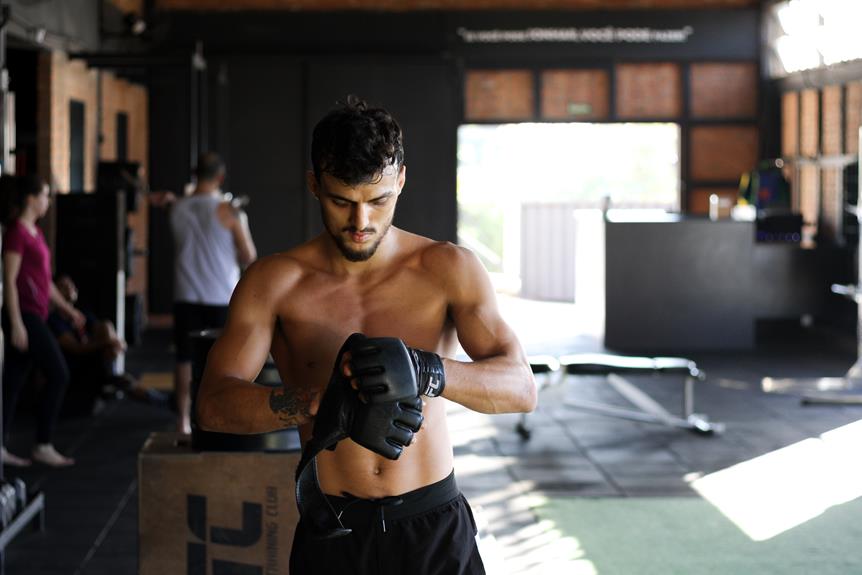In the world of mixed martial arts, size and weight often prove crucial in determining victory. Throughout UFC history, a select few fighters have stood out for their immense stature. These giants, from Emmanuel Yarbrough’s 616 lbs to Gan McGee’s towering 6’10’, have captivated fans and opponents alike.
This article delves into the stories of the 15 biggest UFC fighters of all time, exploring their impact in the octagon and the unique challenges they faced due to their immense size. Get ready to meet the giants of the cage.
Key Takeaways
- Emmanuel Yarbrough and Teila Tuli had the biggest weight differences in UFC history, with Yarbrough weighing in at 616 lbs and Tuli at 415 lbs for their respective fights.
- Thomas Ramirez and John Matua were involved in fights with significant weight differences, with Ramirez being knocked out in 8 seconds and Matua suffering a brutal knockout.
- Koji Kitao and Tim Sylvia also had notable weight differences in their fights, with Kitao’s fight being stopped due to a nosebleed and Sylvia having to cut weight to make the limit.
- Scott Ferrozzo, Paul Varelans, Mark Hunt, Sean McCorkle, Kevin Rosier, Greg Hardy, Derrick Lewis, Tank Abbott, Gan McGee, Semmy Schilt, and Brock Lesnar all carried significant weight in their fights, with some of them struggling with weight issues throughout their careers.
Emmanuel Yarbrough and Teila Tuli
Weighing in at 616 lbs (279.4 kg) for his UFC 3 fight, Emmanuel Yarbrough showcased his immense size and strength in the octagon. Yarbrough’s weight alone raises the question: Should heavyweight fighters have a separate weight class in the UFC?
The heavyweight division already allows for a wide range of weights, but fighters like Yarbrough and Teila Tuli, who weighed 415 lbs (188.2 kg) for UFC 1, demonstrate the extreme end of the spectrum. Size and weight undoubtedly have a significant impact on fighting styles in the heavyweight division.
These fighters often rely on their power and brute force to overpower opponents. However, their size can also be a disadvantage, as it may limit their speed and agility.
Thomas Ramirez and John Matua
But, Thomas Ramirez and John Matua were more than just their size in the UFC. These heavyweight fighters faced unique challenges due to their weight difference and the difficulties of cutting weight in their division. Here are the key points to consider:
1) The impact of weight difference in their fights: Ramirez, weighing 410 lbs, experienced the fastest UFC knockout at the time, getting knocked out in just 8 seconds. Matua, at 400 lbs, suffered a brutal knockout against David Abbott, who’d a weight difference of 120 lbs. This highlights how weight disparities can affect the outcome of fights.
2) The challenges of cutting weight for heavyweight fighters: Unlike fighters in lower weight classes, heavyweights like Ramirez and Matua struggle with the process of cutting weight. It’s physically demanding and can affect their performance and overall health.
Thomas Ramirez and John Matua faced unique challenges in the UFC due to their weight difference and the difficulties of cutting weight as heavyweight fighters. Understanding these factors adds depth to their performances and sheds light on the unique challenges faced by fighters in this division.
Koji Kitao and Tim Sylvia
Koji Kitao and Tim Sylvia were formidable heavyweights in the UFC, known for their size and impressive fighting skills. One of the key factors in their fights was the significant weight difference they often faced.
In the case of Koji Kitao, he weighed 390 lbs at UFC 9, while his opponent, Mark Hall, weighed just 189 lbs. This weight difference of 201 lbs undoubtedly had an impact on the fight.
Tim Sylvia faced challenges in cutting weight as a heavyweight fighter. While his heaviest weight was 371 lbs for a Reality Fighting bout, he had to cut down to 266 lbs in the UFC. This process of cutting weight can be particularly difficult for heavyweight fighters due to their naturally larger frames.
Scott Ferrozzo and Paul Varelans
While Scott Ferrozzo and Paul Varelans may not have had the largest weight differences in their fights, their size and strength still made them formidable heavyweight fighters in the UFC. Here are some key points about these two fighters:
1) Scott Ferrozzo:
- Weighed in at 350 lbs (158.7 kg) for UFC 12.
- Lost by TKO in 43 seconds against Vitor Belfort.
- Despite his height of 5’10’, Ferrozzo’s weight served him well in most fights.
2) Paul Varelans:
- Weighed in at 340 lbs (154.2 kg) and fought in multiple UFC events.
- Known for his large size and strength, as well as his professional wrestling background.
- Varelans was able to utilize his weight advantage in the octagon.
These fighters exemplify the role of size and weight in MMA, showcasing that even without the largest weight differences, their immense size and strength made them noteworthy in the heavyweight division.
Mark Hunt, Sean McCorkle, and Kevin Rosier
Mark Hunt, Sean McCorkle, and Kevin Rosier all faced weight challenges throughout their fighting careers. As heavyweight fighters, managing weight becomes a crucial aspect of their preparation for fights in the UFC. The impact of weight cuts on these fighters can be significant, considering the physical demands and size of the heavyweight division.
Mark Hunt, with a maximum weigh-in weight of 266 lbs, walks around at 310 lbs and has to cut weight for his fights. Similarly, Sean McCorkle, who weighed 334 lbs in his last super heavyweight fight, had a maximum weigh-in weight of 265 lbs in the UFC. Kevin Rosier, who fought at UFC 1 weighing 325 lbs, struggled with his weight throughout his career.
The challenges of managing weight in the UFC are particularly evident in the heavyweight division, where fighters have to find a balance between size, strength, and making weight for their fights.
Greg Hardy and Derrick Lewis
Despite their imposing size and weight, Greg Hardy and Derrick Lewis have faced their fair share of challenges in the heavyweight division of the UFC. These challenges include weight cutting struggles and the impact of their size and power in the division.
Weight cutting struggles: Both Hardy and Lewis often walk around at weights well above the 266 lbs (120.6 kg) weight limit for heavyweight fights. This necessitates significant weight cuts in order to make the required weight, which can be problematic and potentially affect their performance.
Impact of size and power in heavyweight division: Hardy and Lewis carry a significant amount of weight, which gives them an advantage in terms of power and strength. Their imposing physiques and knockout power make them formidable opponents in the octagon.
Tank Abbott and Gan McGee
Tank Abbott weighed in at 298 lbs (135.1 kg) for UFC 11, showcasing his significant size and weight advantage in the octagon. Despite being 5’11’, Abbott’s weight played a significant role in his fighting career. Known for his brawling style, Abbott relied on his power and aggression to overwhelm his opponents. His heavy punches and ability to absorb punishment made him a formidable opponent.
On the other hand, Gan McGee, standing at a towering 6’10’, weighed in at 296 lbs (134.2 kg) for his fight against Josh Barnett at UFC 28. McGee’s weight made him stand out in the super heavyweight division, and his size allowed him to utilize his long reach and powerful striking to his advantage.
Both Abbott and McGee exemplify the impact of size and weight in the fighting strategies of these heavyweight fighters.
Semmy Schilt and Brock Lesnar
Both Semmy Schilt and Brock Lesnar have made a significant impact in the UFC with their formidable size and strength.
Here are four key points regarding the impact of size and weight in the UFC heavyweight division and the controversies surrounding heavyweight fighters:
- Semmy Schilt, also known as ‘The Hightower,’ had a maximum UFC weigh-in of 261 lbs (118.4 kg) but bulked up to 291 lbs (132 kg) in Glory Kickboxing. His height and relatively thinner build allowed him to carry significant weight, and if there were no weight limit, he could have easily reached well above 300 lbs.
- Brock Lesnar, whose walking weight is around 290 lbs (131.5 kg), cuts down to make the 266 lbs (120.6 kg) weight limit. He rehydrates to around 280-285 lbs for his fights, and his size and muscle mass have raised suspicions of steroid use.
- The impact of size and weight in the UFC heavyweight division is significant, as fighters like Schilt and Lesnar possess a physical advantage over their opponents. Their strength and size allow them to impose their will and dominate fights.
- Controversies surrounding heavyweight fighters often revolve around issues of weight cutting, allegations of performance-enhancing drug use, and concerns about fairness and safety. The ability to manipulate weight and possess immense strength can create an unlevel playing field, leading to debates about fairness in the sport.
These two fighters have left a lasting impact on the UFC, showcasing the influence that size and weight can have in the heavyweight division while also raising important questions and controversies within the sport.
Antonio Silva
Antonio Silva, weighing in at 285 lbs (129.2 kg), has established himself as a formidable presence in the UFC heavyweight division. Silva’s fighting style and techniques have contributed to his success in the octagon.
Silva is known for his aggressive striking and his ability to utilize his size and reach advantage to dominate his opponents. Throughout his career, Silva has showcased his knockout power, with several of his victories coming by way of knockout.
One of his career highlights includes a memorable knockout win over Alistair Overeem, where he displayed his striking skills and resilience. Silva has also had notable battles against top contenders such as Cain Velasquez and Mark Hunt, demonstrating his ability to compete against the best in the division.
The Heaviest UFC Fighters of All Time
Despite their impressive size and weight, several UFC fighters throughout history have tipped the scales as the heaviest competitors in the octagon. The impact of weight cutting on heavyweight fighters and the role of size in their success can’t be ignored. Here are some of the heaviest UFC fighters of all time:
- Emmanuel Yarbrough and Teila Tuli: Yarbrough weighed in at a staggering 616 lbs (279.4 kg) for his UFC 3 fight, while Tuli weighed 415 lbs (188.2 kg) for UFC 1. Yarbrough had a huge weight difference of 416 lbs (188.7 kg) when he fought against Keith Hackney.
- Thomas Ramirez and John Matua: Ramirez weighed 410 lbs (186 kg) and fought against Don Frye, resulting in a weight difference of 204 lbs (92.5 kg). Matua weighed 400 lbs (181.4 kg) and fought against David Abbott, with a weight difference of 120 lbs (54.4 kg).
- Koji Kitao and Tim Sylvia: Kitao weighed 390 lbs (176.9 kg) and had a weight difference of 201 lbs (91.2 kg) when he fought against Mark Hall. Sylvia, a two-time UFC heavyweight champion, had a maximum weigh-in weight of 266 lbs (120.6 kg) but had to cut weight from 300 lbs (136 kg) to make the limit.
- Scott Ferrozzo and Paul Varelans: Ferrozzo weighed in at 350 lbs (158.7 kg) and lost to Vitor Belfort. Varelans weighed 340 lbs (154.2 kg) and fought in multiple UFC events.
The impact of weight cutting on heavyweight fighters is evident, as many of these fighters had to cut significant amounts of weight to compete. Size does play a role in the success of heavyweight fighters, as their weight advantage can be utilized in the octagon.
The Fastest Knockouts by Heavyweight Fighters
The fastest knockouts by heavyweight fighters have left audiences stunned and fighters dazed. When it comes to heavyweight fighters, their immense power and size can lead to explosive knockouts in the blink of an eye. The key to achieving a fast knockout lies in the implementation of effective techniques and strategies.
Heavyweight fighters often rely on their natural strength and power to deliver devastating blows. One of the fastest knockout techniques commonly employed by these fighters is the one-punch knockout. By utilizing their size and strength, they’re able to generate immense force behind their punches, resulting in quick and devastating knockouts.
Another strategy used by heavyweight fighters is to capitalize on their opponent’s vulnerabilities. By studying their opponent’s weaknesses and exploiting them, they can land precise and powerful strikes that can quickly end the fight. This requires a deep understanding of their opponent’s fighting style and a high level of skill and accuracy.
UFC’s Super Heavyweight Legends
With their massive size and incredible strength, UFC’s Super Heavyweight Legends have left an indelible mark on the sport.
The super heavyweight division’s impact on the UFC can’t be ignored, as these fighters have showcased their extraordinary power and ability to absorb punishment.
However, one of the challenges faced by heavyweight fighters is weight cutting. Due to their naturally larger frames, many of these fighters have to undergo significant weight cuts to meet the 266 lbs (120.6 kg) limit. This can be physically and mentally demanding, as it requires strict dieting and dehydration methods.
Despite these challenges, the super heavyweight division continues to captivate fans with its awe-inspiring displays of strength and athleticism.
Weight Cutting Challenges in the UFC
Due to their larger size and the need to meet weight limits, heavyweight fighters in the UFC often face challenging weight cutting processes, but they persevere in their pursuit of success.
The challenges of extreme weight cutting can be especially daunting for these fighters, as they’ve a significant amount of weight to shed in order to make their designated weight class. This process can involve strict dieting, intense workouts, and even dehydration techniques such as saunas or hot baths.
However, it’s important to note that weight cutting can have serious health risks. Rapid weight loss can lead to dehydration, electrolyte imbalances, and even organ damage.
Despite these challenges and risks, heavyweight fighters in the UFC continue to undergo weight cutting in order to compete at their desired weight class and maximize their chances of victory.
Controversies Surrounding Heavyweight Fighters
In recent years, controversies have arisen surrounding the actions and behavior of heavyweight fighters in the UFC. Here are some of the controversies that have surrounded these fighters:
- Steroid use allegations: Several heavyweight fighters have faced allegations of using performance-enhancing drugs, specifically steroids, to gain an advantage in their fights. This has led to suspensions, fines, and tarnished reputations for those involved.
- Weight class controversies: The heavyweight division in the UFC has always faced challenges when it comes to weight cutting. Some fighters struggle to make the 266 lbs weight limit, leading to missed weight and potential health risks. This has raised questions about the effectiveness of weight classes in accommodating the size and weight of heavyweight fighters.
- Behavioral issues: Heavyweight fighters have been involved in various behavioral controversies, including trash-talking, pre-fight altercations, and post-fight misconduct. These actions have drawn criticism from fans, fellow fighters, and the UFC itself, as they reflect poorly on the sport and its athletes.
- Controversial fight results: Some heavyweight fights have ended in controversial decisions or stoppages, leading to disputes and debates among fans, fighters, and experts. These controversial outcomes can create tension and controversy within the division and impact fighters’ careers and legacies.
These controversies surrounding heavyweight fighters highlight the complexities and challenges that come with competing in the highest weight class in the UFC.
The Impact of Size and Weight in UFC Heavyweight Division
Size and weight significantly shape the dynamics and outcomes of fights in the UFC heavyweight division. The role of weight advantage in heavyweight fights can’t be understated. Fighters with a significant weight advantage often have the ability to impose their physicality and dominate their opponents.
However, the physical limitations of heavyweight fighters should also be taken into consideration. The sheer size and weight of these athletes can sometimes result in reduced speed, agility, and endurance. Additionally, the strain that carrying excess weight puts on their bodies can lead to increased risk of injuries and health issues.
It’s a delicate balance for heavyweight fighters to maximize their size advantage while maintaining their physical abilities. Finding the right balance between size, strength, and overall athleticism is key for success in the UFC heavyweight division.
Conclusion
In conclusion, the biggest UFC fighters of all time have left a lasting impact in the octagon, showcasing their immense size and weight. From Emmanuel Yarbrough’s staggering 616 lbs to Gan McGee’s towering 6’10’ frame, these giants have brought a level of intimidation to the sport.
However, their size has also presented unique challenges, such as weight cutting issues and controversies.
Overall, the impact of size and weight in the UFC heavyweight division can’t be underestimated, making these fighters true legends of the sport.
- 15 Best Martial Arts Weapons (Fighting & Training) - October 14, 2024
- Is Fencing a Martial Art? (Yes, 4 Reasons Why) - October 14, 2024
- 7 Best Martial Arts for Self-defense Ranked (Highly Effective) - October 14, 2024










